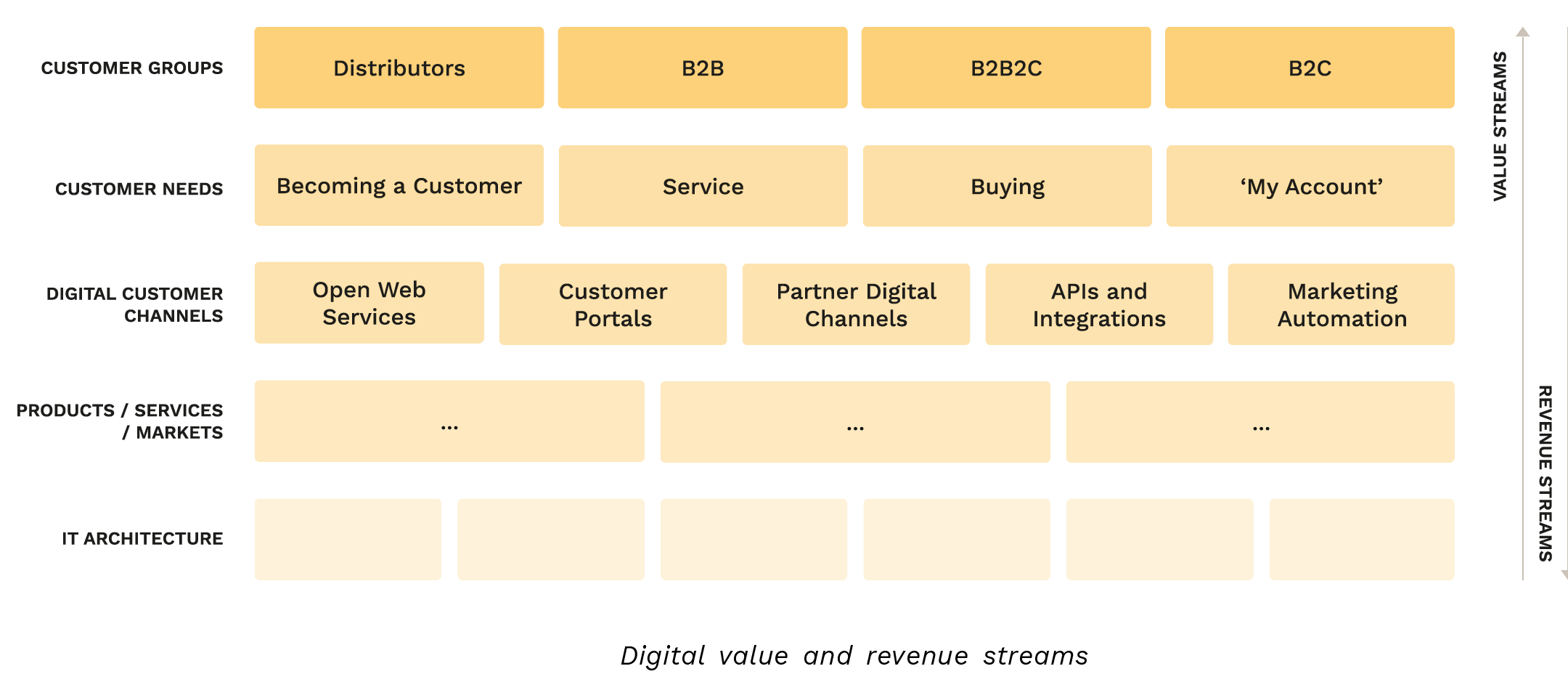The Data Handbook
How to use data to improve your customer journey and get better business outcomes in digital sales. Interviews, use cases, and deep-dives.
Get the bookTaking sales online can be a complex process and it’s not always clear what to invest in first. The key is to break the buying process down into pieces and start with the areas that offer the most potential for impact.

The digital-sales landscape comprises countless solutions and touchpoints that affect a wide variety or processes in a company. This landscape can become very complex in the enterprise context, where one company can serve both B2C and B2B customers in multiple markets, have many types of transactions with its clients, and offer a wide portfolio of products and services.
For large companies in particular, it can be challenging to make reasoned investment decisions in digital sales. It can also be tough to decide which point to start the digital transformation journey from. All too often, companies are pouring capital into areas with limited business impact, while alternatives would provide a much higher return on investment.
For example, a typical mistake is to invest in complex IT systems, when lighter investments in the optimisation of current systems or processes – such as customer messaging – would pay off with much faster and offer less risky returns. At the other end of the spectrum, companies sometimes become over cautious – and even paralysed – through their inability to identify smaller initial investments, when everything seems to be related to everything.
To identify the most impactful targets for investment, it is crucial to form an overall understanding of how, why, where, in what situations and through which touchpoints customers buy and interact with the company. This understanding should ideally lead to being able to identify and prioritise digital value streams and synergies between functions. This in turn should enable holistic and reasoned decision making across all digital solutions and touchpoints.

The above figure provides a framework for structuring digital value streams. The main purpose of this framework is not to provide a single solution for directing digital investments. Rather, it is to help leaders structure and mentally carve the landscape of digital commerce into smaller pieces, so it is easier to make decisions that result in incremental business-focused investments.
Understanding the business value of your digital services
When defining business cases for digital sales investments, two points should be remembered. First, it is difficult to completely separate digital sales investments from generic investments in digital services. Second, investing in digital sales typically has a positive impact not only on the blog-, but also brings efficiency gains below the line in the form of fewer manual sales processes that are also more streamlined.
When defining the business cases for investments in digital sales and solutions, the following areas of business impact should be considered:
● Revenue: Being able to attain more volume and getting more people to convert more often with higher average purchases and lower churn
● Efficiency: Reducing the number of salespersons or the amount of customer service involvement in sales processes by using digital touchpoints and automation
● Customer satisfaction: Customers often prefer buying digitally and find it more convenient, plus they appreciate the 24/7 availability
● Brand: Improving digital touchpoints should always have a knock-on positive impact on brand
For each digital solution and touchpoint, it is crucial to define the area of business impact. For example, the main website of a company can provide more leads, generate direct sales, boost the brand, increase customer satisfaction and drive efficiency (through more people using digital customer services). Even such a simple thing as a live customer-service chat on a website can increase online leads by an average of 40 percent, according to some studies.
When a high-level understanding of the business impact of each service has been defined, it can be useful to map the services that cater to similar kinds of customer needs. In a large organisation, there can be many solutions that help customers to fulfil similar needs. Typically, the solutions serving similar needs require the same core functionalities, and can therefore share the same IT components.
For example, when a company has identified that its best business case lies in making the continuous transactions of small-business clients more efficient, the company could simultaneously optimise all digital touchpoints that serve the same need. In this example situation, the customer touchpoints to be optimised could be online purchasing, digital portals, customer service, and field sales tools.
A holistic understanding of digital sales enables incremental business-focused investments
Ultimately a systematic way of leading and growing digital sales requires a shared understanding of digital value streams, customer journeys, and what the strategic goal is at any given time. This ensures that decision making at different levels can take place in a more objective fashion, it reduces the risk of overlapping development projects, and it prevents people sub-optimising those areas that are not on their radar. The challenge is that digital sales is not typically thought of as a holistic concept, nor as something that should lead from the centre of a business.
Getting started does not require massive investments. The first step is to generate a good enough shared overall understanding of the value streams of digital sales and to identify the most prominent investment opportunities based on numbers. Thereafter, it is possible to get started in a lean manner by investing in a single solution, product area, or service with a limited set of customers. Scaling to other areas can follow later.
Here you can find a checklist with the main points to consider while striving to optimise digital sales and business revenue. It is intended for business directors, leaders and managers at all levels in different-sized organisations and across industries.
- Get to know the status quo. Most of the problems the company and people struggle with are not visible to upper management. Talk to people. Seek to understand their daily struggles and the customer viewpoint. Call your customers.
- Identify the role of each service and channel for each customer group or segment along the customer journey.
- Identify the relevant business impact and potential for a selected customer group or segment. If there are many services in the company’s service portfolio, identify the impact per service.
- Strive to understand which services have the most impact, and which do not.
- Assess the level of current investments to determine whether budgets are in line with business potential. If there’s a mismatch, take corrective action.
- Prioritise your efforts. Don’t do everything at the same time and avoid getting stuck. Start lean.
- Start optimising and streamlining selected service areas based on identified key metrics (e.g. customer retention).
This blog was written together with my amazing colleague Eero Martela, thank you!
Learn how to thrive at the turning point of digital sales by reading The Digital Sales Transformation Handbook. Discover how digital sales transformation is changing companies, and how your business can leverage this change through organisational development, customer experience, ways-of-working and technology. Featuring interviews with industry experts, such as Marta Dalton (eCommerce Director for Unilever and Coca-Cola previously), Risto Siilasmaa (Founder of F-Secure) and Antti Kleemola (CDO of VR, Finnish Railways).
The Data Handbook
How to use data to improve your customer journey and get better business outcomes in digital sales. Interviews, use cases, and deep-dives.
Get the book




